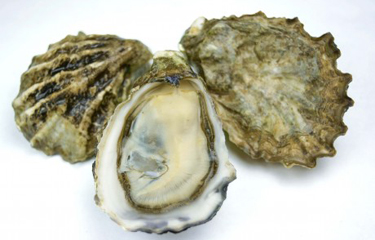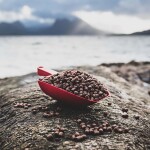 2.) 1999 Seattle Oyster Olympics: Olympia and Kumamoto oysters
2.) 1999 Seattle Oyster Olympics: Olympia and Kumamoto oysters
The Olympia (Ostrea luridis) from the Olympia Oyster Co., in Shelton, Washington, in the United States is the epitome of umami; it’s more of an experience, than a bite, chew, or swallow. Grown in Puget Sound, the oyster itself is no bigger than a 50-cent piece after four years of growth. Because it is small and wafer-thin, it creates an interesting shucking situation – requiring fingertip control – but it just melts across the palate and is best enjoyed without any sauce or condiment. As the most complex oyster out there, it’s also best enjoyed with your eyes closed. With regards to the Olympia experience, (nose first) you’ll get clean, bright ocean air and a hint of copper and seaweed. Then slide the oyster across your lips, bruise it gently with your tongue, take two bites and let it melt across your palate for salt, sweet cream, earth, fresh cut grass, driftwood, stone and copper/brass – all of which can take up to one-and-a-half minutes to develop, and will last as a pleasant experience on the palate for many minutes afterwards.
The Kumamoto (Crassostrea sikaema) is originally from the Kumamoto Prefecture in Japan. It was first brought over to the United States in the 1920s and has been cultured by Taylor Shellfish since the 1980s. The shell is the perfect giveaway as to who raised these oysters: While there are several growers of the Kumamoto species in North America, only Taylor has perfected the pure-bred shell and texture.
In 2002, when I first opened Starfish in Toronto, I ordered some Kumamotos and when they arrived I discovered a perfect deep-cup shell, ‘cat’s paw’ fluting and buttery ocean nugget within. They were the best I had ever seen. I called Bill Taylor directly, just to ask where these oysters had been hiding. He told me that he had been ‘sitting on them for the past 20 years’ and that they were found in the 1980s in ‘carpets’ of pure-bred Kumamotos that had been lost to time and tide since the ‘20s, when these were imported by one Japanese oyster farmer and grown until he passed [away]. The beds were forgotten until Taylor’s survey team found them decades later. Bill knew right away that they were something special and took time to culture them to the perfection that they are today. The Kumamoto gives soft ocean sea salt up front, but sometimes the salt is in the finish – it switches. It has a firm texture, with sweet cream/buttery notes and a melon (white rind) and cucumber freshness in the finish.
Where to find them: Sadly, the Oyster Olympics no longer exists. It was a fantastic event of skill – shucking five species, a dozen of each – timed and judged. Team Canada won in 1999 [McMurray was the shucker]. But to enjoy the oysters today, explore the Chuckanut Trail – Seattle to Vancouver – providing the most picturesque drive into the Puget Sound area. There is an oyster bar next to the Taylor Shellfish farm to stop at for a few shells, while any of the Taylor Shellfish Oyster Bars in Seattle will set you straight.






